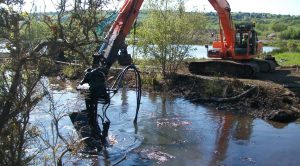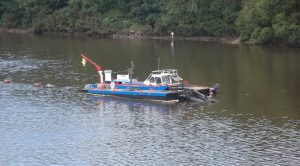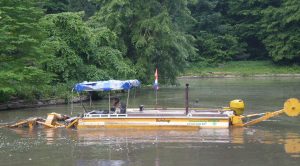DREDGING & DESILTING
GeoEnvironmental uses Dutch technology to de-silt and dredge water bodies. These environmentally friendly methods have been developed over the years to overcome the damage caused to fluvial, lacustrine and riparian habitats by more conventional shore based dredging methods.
Cutter suction dredgers
Cutter suction dredgers are generally mounted on floating craft and allow thin layers of material to be removed from the lake or river bed. The sediments are pumped ashore using floating flexible pipes. This method avoids riparian damage and minimises damage to the river and lake bed. The pumps used are powerful enough to transport silt up to a kilometre away from the water body allowing the silt collection and treatment area to be away from the delicate riparian habitat.
Pump-based de-silting
Purpose-designed silt pumps are used to agitate the sediment and pump it via flexible pipes to the land. This technique can be used by a floating vessel in larger water bodies by an operator wading in the smallest channels. This method avoids riparian damage and minimises damage to the river and lake bed. The pumps used are powerful enough to transport silt up to a kilometre away from the water body allowing the silt collection and treatment area to be away from the delicate riparian habitat.
Excavator mounted equipment
Excavator mounted clam shells operated from a pontoon can utilise materials handling pumps to transfer the sediment back to land using flexible pipes. The pumps used are powerful enough to transport silt up to a kilometre away from the water body allowing the silt collection and treatment area to be away from the delicate riparian habitat.
- Cutter suction dredging
- Hydraulic materials pump dredging
- Excavator mounted clam shell
- Hand operated suction dredging



